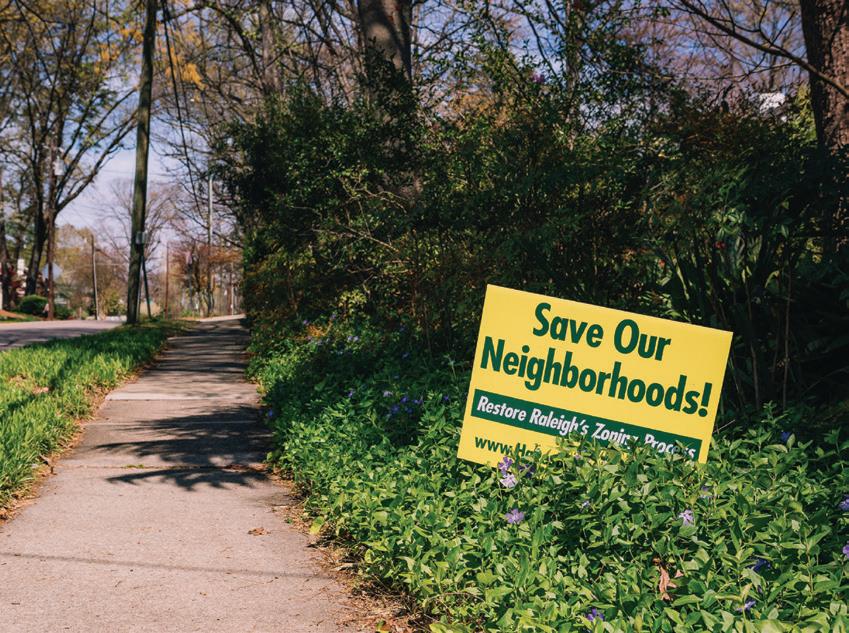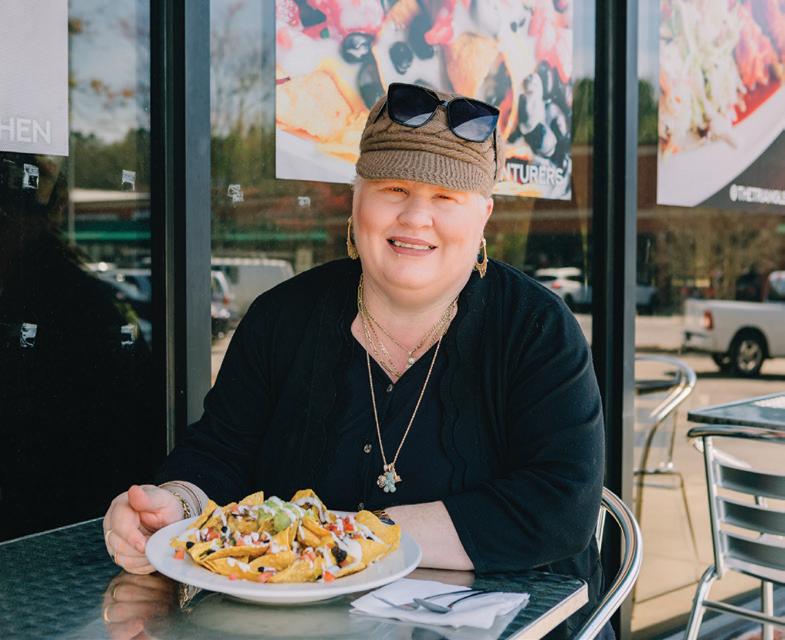Mis- Influenced
byWhen a small Durham restaurant received a negative review from a popular content creator, the comments rolled in. So did the death threats.
Lena Geller, p.12

When a small Durham restaurant received a negative review from a popular content creator, the comments rolled in. So did the death threats.
Lena Geller, p.12
VOL. 40 NO. 13
6 Raleigh's city council works to find common ground with residents over its missing-middle-housing policy. BY
JASMINE GALLUP8 Durham's dog court decides the fate of the county's "dangerous" canines.
BY JACQUELINE COLE10 Durham minister Paul Scott urges J. Cole to cancel Dreamville over the state's proposed "anti-woke" bill. BY
THOMASI MCDONALD12 In early March, Durham restaurant Earth to Us was on the receiving end of a negative review from a popular content creator. Things went downhill from there BY
LENA GELLER14 Talking with Chapel Hill writer Daniel Wallace about his new book, This Isn't Going to End Well: The True Story of a Man I Thought I Knew
BY CARR HARKRADER16 Dungeons & Dragons: Honor Among Thieves just may be the sneaky commercial hit of the season.
BY GLENN MCDONALD17 Mighty Poplar is bluegrass's newest supergroup. BY
NICK MCGREGOR
18 New collective eggNYMPH stages The Aliens, Annie Baker's play of generational discontent. BY
BYRON WOODS3 Backtalk 4 Quickbait 21 Culture calendar
Matty Frank performs at The Pinhook's LGBTQ Center Benefit on Sunday, April 2. (See calendar, page 21.)
PHOTO COURTESY OF THE PINHOOK.
PUBLISHER
John Hurld
EDITORIAL
Editor in Chief
Jane Porter
Managing Editor
Geoff West
Arts & Culture Editor
Sarah Edwards
2023
Staff Writers
Jasmine Gallup
Lena Geller
Thomasi McDonald
Copy Editor
Iza Wojciechowska
Interns
Sarah Innes, Nathan Hopkins
Contributors Spencer Griffith, Carr Harkrader, Brian Howe, Kyesha Jennings, Jordan Lawrence, Glenn McDonald, Nick McGregor, Gabi Mendick, Shelbi Polk, Dan Ruccia, Byron Woods
CREATIVE
Creative Director
Nicole Pajor Moore
Graphic Designer
Izzel Flores
Staff Photographer
Brett Villena
ADVERTISING Publisher
John Hurld
Sales Digital Director & Classifieds
Mathias Marchington
CIRCULATION
Berry Media Group
MEMBERSHIP/ SUBSCRIPTIONS
John Hurld
INDY Week | indyweek.com
P.O. Box 1772 • Durham, N.C. 27702
Durham 320 East Chapel Hill Street, #200
Durham, N.C. 27701 | 919-286-1972
Raleigh: 16 W Martin St, Raleigh, N.C. 27601
EMAIL ADDRESSES
first initial[no space]last name@indyweek.com
ADVERTISING SALES
advertising@indyweek.com
Raleigh 919-832-8774
Durham 919-286-1972
Classifieds 919-286-6642
Contents © 2023 ZM INDY, LLC
All rights reserved. Material may not be reproduced without permission.
From reader SARAH PEARSON via email:
“Luxury townhomes selling for two million dollars is not affordable housing which is what the missing middle is supposed to address. I live in Raleigh and see this happening all over the city. My own neighborhood was affordable. Now developers come in and tear down modest homes, cut all the trees and build more expensive houses. I’ve come to realize a developer is simply doing what is allowed. It’s the way the business works. At fault is the city that not only allows these practices but encourages them. Hopefully this lawsuit will be successful and a new, better way to move forward is found.”
From reader DAVE CONNELLY via email:
“Interesting article. Most residents of Hayes Barton live in election precinct 01-05. The majority of votes cast in the November 2020 election in that precinct were for Democrats, up and down the ballot. So—progressive when picking their politicians, yet regressive when picking their neighbors. My irony detector has just started smoking.”
From reader BOB GILBERT via email:
“The Raleigh text changes and unlimited development unleashed on Raleigh have not only *not* created more affordable housing, according to recent commercial real estate data and news, Raleigh has a glut of empty high end commercial and high end residential units as high as 18% vacancy, and a dearth of affordable housing and sf homes to the tune of thousands of units a year. And now even John Kane abandoned his crazy plans for maxing out North Hills.
Also last time I checked $2 million townhomes are not affordable housing.
Missing middle over incentivized rapid high end development and under incentivized needed community benefits like infrastructure, transportation and affordable housing.
And that’s why half the city council was replaced and Mayor Baldwin won by only
10,000 votes while having 15 times the campaign cash.
Disdainfully focusing on only one neighborhood’s reaction left out the fact that the overall result of this year’s Missing Middle neighborhood meetings were resoundingly negative in the whole city, not just Five Points. And there are and were objectionable projects in all districts.
The new City Council are remaking Community Engagement which was eliminated as a method, excuse and pretext to this zoning tragedy, as a number one priority and we have already seen good progress from them in that direction.
We are all for truly affordable housing, infrastructure, better transportation and a more sustainable city but this method is proving how to do the exact opposite.
Not clear cutting lots and cramming the maximum high end homes on them and calling that affordable.”
Read Gallup’s report on Raleigh’s missing middle housing policy on page 6.
We also continue to get reader feedback on our reporting on Durham’s SCAD proposal, including this message from Durham resident, SCAD opponent, and newly announced city council candidate SHERRI ZANN ROSENTHAL responding to an op-ed we published from Durham resident Bob Chapman the week before last.
“Bob Chapman’s splashy piece in the Indy was a snow job, part of a PR campaign by the real estate industry meant to convince us to give developers enough loopholes to price us all out of town. ‘SCAD’ will speed up the current displacement [of] people of color and nonrich folks from Durham, while making scads of cash for developers.
Yet the most powerful faction of the City Council—Johnson, Caballero, Middleton and Williams—seem to have swallowed this whole, saying they believe developers know best.
At their May 1 council meeting, the Council will probably vote to accept these destructive changes—unless they hear strong opposition from you. ...



Here are the two big lies of Chapman’s article: 1. That SCAD is anti-racist. 2. That it will create affordable housing.
Using Hayti’s destruction as a way to sell the Anthony Amendments is a cynical ploy. The Hayti disaster was a bait-and-switch, where the community was promised investment and renewal, but instead got displacement and demolition.
Our problem isn’t the number of houses. The problem is affordability. DataWorks documents that Durham’s ratio of people to housing units 20 years ago is about the same as today.
Deregulation as proposed by SCAD won’t fix affordability. Part of SCAD is taking the small lot option and putting it on steroids: tinier lots, taller and bigger houses, no room for trees or storm water. Existing relatively affordable houses are demolished and replaced by 3–4 on tiny lots—which go for $450k and up.
The small lot option and SCAD open up settled neighborhoods for new profit extraction. There’s a lot more profit to be made from 3–4 new small homes than the real estate commission from the sale of existing homes. Yet the total number of houses created won’t move the needle on supply.
Trickle-down housing is as fake a theory as trickle-down economics. Affordable? No.
Our public policy should be investment and renewal, preserving Durham’s sense of place and providing more affordability than new construction can.
Deregulation of the real estate industry is a bad idea. We need common sense, effective regulation to protect neighbors from ruin.Look into the substance of these complex amendments and let the Council know your thoughts well before May 1.”
Last week for the web, Jasmine Gallup reported on a lawsuit that six Hayes Barton homeowners are bringing against the City of Raleigh concerning its new missing-middle-housing policy. Readers had thoughts.
AQseries of community meetings on Raleigh's missing-middle policy earlier this year led to heated conversations between residents and city staff. Last week, staff summarized the feedback they got from residents on the city's new zoning rules. Here are some of the top answers residents gave to questions about growth, housing, and missing middle.
by: Estimated number of participants:
55+
People over 55 years old
Those living with children Homeowners
Of the 11 missing-middle/UDO changes made over the past two years, which ones do you think work well for your neighborhood?
What are your concerns with the changes that you don’t think work well?
What concerns do you have about change in your neighborhood?
How do you think we can make Raleigh more sustainable, transitsupportive, and affordable for all families who want to live here?
Which issues do you think the city should focus on to help manage change?
Source: the City of Raleigh




The Raleigh City Council may make changes to its missing-middle-housing policy to address residents’ concerns about affordability, community engagement, and the environment.
BY JASMINE GALLUP jgallup@indyweek.comThe Raleigh City Council’s progressive missing-middle-housing policy looks like it’s here to stay following a conversation last week between longtime council members and newly elected representatives.
Some voters were worried that the city council’s four new members, elected in November of 2022, would push to end “missing middle,” a set of policy changes that allow developers to build a greater variety of housing units such as duplexes, townhomes, and accessory dwelling units (ADUs) in traditionally single-family neighborhoods. The policy was a focal issue during the last election and remains a major focus of today’s debates over local politics.
Many older, longtime homeowners adamantly oppose the policy, arguing it damages “neighborhood character,” has a negative impact on the environment, and doesn’t actually guarantee the creation of more affordable housing. Other city residents argue that the missing-middle policy is a long-overdue update to Raleigh’s exclusionary zoning practices, which helped contribute to the current affordability crisis.

Despite extreme arguments on both sides, the city council seems poised to compromise on possible reforms to the missing-middle policy. During a workshop last week, council members talked about addressing residents’ concerns about affordable housing, community engagement, and the environment.
One common complaint about missing middle is that it doesn’t guarantee the construction of affordable
homes. During a series of neighborhood meetings earlier this year, dozens of people brought up affordability as one of their top concerns about the missing-middle policy.
“I’m in Boylan Heights, an older neighborhood that does have a lot of these missing middle types,” said one Raleigh resident, according to a report by city staff. “The costs have gone up so much that my neighbors could not afford to buy now.”
Mayor Mary-Ann Baldwin and other city council members have argued that the policy itself will help create more affordable housing. Smaller homes, by their nature, are more affordable than large, single-family homes in the same area. Older neighborhoods like Boylan Heights and Oakwood will continue to be expensive, but the policy also creates room for smaller homes in other parts of Raleigh, where property values are generally lower.
“Across the country, [people using missing-middle] are simply trying to return development rules to what they were before World War II,” says Eric Braun, a former land use lawyer and six-year member of the Raleigh Planning Commission. “[Those neighborhoods had] different types of housing and even small, small commercial uses. If [the policy] is allowed to really develop over time and be implemented fully, it allows people that have different income levels to move to more places across the city.”
When it comes to guaranteeing that new construction is affordable, the city council is limited in what it can legally do. Inclusionary zoning, a tool that mandates developers build affordable homes, is banned under state law. Last week, however, council members talked about possibly raising that issue with the state legislature, as well as exploring other strong tools they could use to
incentivize affordable housing.
“One of the ongoing themes is really affordability, regardless of the [housing] type. That’s something we can look at,” said Mayor Pro Tem Corey Branch during the work session. “Look at the tools we have available currently, and if there’s something else that may be out there. Have conversations with county, state, and federal government about options to incentivize affordability.”
Baldwin added that the city council is working with the Urban Land Institute on a study that will help members learn what other cities are doing to incentivize affordable missing-middle housing.
New council members focused more strongly on affordable housing, suggesting the city council should be doing more.
“This is a continual need,” said council member Jane Harrison. “As we accelerate redevelopment opportunities here, we have to think about displacement pressures …. What are we already doing in terms of antidisplacement work? … How do we also tie that back to this missing-middle program, so that it’s clear we are making those commensurate investments? So we are not further pushing people from their neighborhoods?”
Harrison suggested the city council consider developing an antidisplacement plan, like the one created by the city of Portland, Oregon. She also asked about instituting new rules for the sizes of homes allowed to be built under the “missing middle” policy. Limiting square footage, she said, could contribute to affordability.
City council member Megan Patton agreed, saying she wanted the city council to explore tweaking missing-middle rules on square footage and setbacks to “get construc-
tion that will lend itself to affordable options.” Council member Christina Jones said she wants to ensure the city council delivers on its promises to increase affordability.
“I don’t want to say we’re gonna do this and then not have it in place so it’s effective and really helping the people that need it,” she said.
City staff are expected to give a report to the city council later this year on the number and types of homes that have been constructed under the missing-middle policy.
One of the biggest complaints about missing middle is that it prevents residents from commenting on or managing new construction projects. Under the city council’s old rules, developers who planned to build townhomes or apartments in traditional single-family neighborhoods might have been required to notify nearby residents and hold community meetings to discuss their plans.
In the age of community advisory councils (CACs), residents sometimes banded together to oppose such projects, forcing the developer to compromise on the construction design or recommending the city council deny a rezoning request.
Under the missing-middle policy, developers can now build many different types of housing “by right,” without notifying residents or requesting a change to zoning rules from the city council. This has angered longtime Raleigh residents who don’t want developers building taller, denser buildings in their neighborhoods, especially ones that don’t “fit in” with the existing aesthetic.
“[The unified development ordinance] can seem like a rubber stamp—projects go through without any public comment,” said one resident during a series of meetings on missing middle, according to a report by city staff. “[The] surrounding community could provide valuable feedback.”
Another resident put it more bluntly: “The problem I have is that we no longer have any input; council has given the role to the staff to decide.”
With missing middle back on the table, the city council could add notification or neighborhood meeting requirements to the policy, which might hamstring developers who want to take advantage of the now-flexible zoning rules. On the issue of community engagement, council member Jonathan Melton said he was happy to discuss possible changes to the missing-middle policy but had some concerns.
“If we require a neighborhood meeting, with the understanding that the intent of these text changes is to allow these developments by right, I’m worried people are going to come with the expectation that there’s going to be some sort of vote or impact on the process, and that’s not going to be there,” he said. “We have to be careful about that, because we don’t want to create more confusion.”
Moreover, Melton said, why should a neighborhood meeting be required for townhomes but not single-family homes, if both are being built under the same zoning rules?
“If someone can build a mansion next to my house
and I have no say in [it] … because that’s their property and that’s allowed by right, why do I have to weigh in if someone can build a duplex or a quad or some townhomes?” Melton said. “What message are we sending about the types of people that live in big, single-family, expensive homes, and the types of neighbors we welcome into multifamily living?”
Council member Jones, also former chair of the Raleigh CAC, was one of the biggest advocates for more community engagement when it comes to missing middle.
During the community meetings the city held earlier this year, there were some very heated discussions between residents and city staff. Those show that people are frustrated with how missing middle was enacted, with little community engagement, Jones said.
“I understand it was COVID … but now the community’s out here, asking to be heard and we have to do that,” Jones said. “That just speaks to how much this community wants to be involved in the decision. That community engagement piece is critical. We can’t do this without their voices. I’m really looking forward to seeing how we can reform.”
Other city council members, including Harrison and Mary Black, agreed community engagement was an important piece of missing middle. Although the city was able to get a more diverse population to participate in the missing-middle meetings earlier this year, young people, renters, and people of color were still underrepresented.
Minimum Lot and Site Width Standards
Accessory Dwelling Units (also known as ADUs)
Attached Houses (also known as duplexes)
Two-Unit Townhouses
Density Changes
Townhouses in R-6
Small Apartments in R-10
Tiny Houses
Flag Lots
Compact and Conservation Developments
Frequent Transit Development
Still, “I feel like we’re on the right track,” said Pat Young, the city’s director of planning and development. “The social media engagement was much more than we’ve ever done, and using radio ads to reach the Black community. It moved the needle. There was a lot more diversity at these meetings than in previous engagements. [It] still didn’t reach the level of full representation, but it was a big improvement.”
Melton and Black each said they wanted to see more young people and renters participate in discussions. Black added that it was important for the city to continue to reach out to people of color and people across different income levels.
“As a young renter in the city, I think it’s important for us to be activating our own political autonomy in talking about the city we want to create,” Black said.
“What I hear when I talk to renters is that they don’t feel a part of this process—that things are changing and growing, but it’s happening to them, without their concerns being a part of it. We have opportunities now to be really thoughtful about [engagement], especially with regards to renters, since we make up so much of the population.”
Overall, new council members seemed on board with the missing-middle policy, although the city council as a whole plans to continue discussing possible reforms. Harrison in particular wants to ensure trees continue to be protected, possibly through changes to the missing middle rules around setbacks and neighborhood transitions. The city council is also still working on a new policy to enact tree protections for lots under two acres.
Harrison and Patton each said the city should continue educating residents about how zoning rules have changed and give them an easy way to find out about the rules in their area. Both have heard from people in their districts who are confused about what is and isn’t allowed under the missing-middle policy.
Ultimately, one of the strongest statements on missing middle came from Patton, who said she wanted to look at how (and why) missing middle allows large construction projects on small lots. This could lead to a discussion about reducing the overall density allowed by the policy.
“There’s a big spectrum here,” she said. “OK, a duplex [can be built right beside me]. That is a modest change. But there are ways people can assemble larger lots. Then, suddenly a community’s looking at something like 16 townhomes being built on the acre of land next to them. That feels a little more impactful …. I think we could use some analysis there.”
Patton’s statement likely alluded to the controversial townhome project in Hayes Barton, where a developer plans to build 17 townhomes on about two acres. Nearby homeowners are suing Raleigh over the project in hopes of overturning missing middle entirely. So whether the future of the policy will be determined by the city council or by a judge remains to be seen. W
“As a young renter in the city, it’s important to us to be able to be activating our own political autonomy in talking about the city we want to create.”
On December 2, 2021, Jazmine Bunch had a small birthday celebration for Stormi, her Maltese/Yorkie mix. The dog wore a pink party hat and got a dog-friendly cake. A few hours later, Bunch took Stormi to a dog park, where she got loose and encountered a gray pit bull named Savvi-Blue that attacked her.

Bunch rushed her dog to the vet, but it was too late. Stormi had died.
A day later, the Animal Services Division of the Durham County Sheriff’s Office dispatched Deputy Ashley Coward to investigate. She collected photos, medical reports, vaccination records, and witness statements to determine the level of risk posed by the dog. The conclusion: Savvi-Blue was “potentially dangerous.”
This is Durham County’s process for dogs that are found to pose a risk to other animals or people. After an investigation, a dog is deemed by a sheriff’s deputy to be “dangerous” (if it has killed or severely injured a human) or “potentially dangerous” (if it has killed or severely injured a domestic animal). The dog is then subject to restrictions that include muzzling in public and requiring the owner to post a warning sign outside the residence. The dog must also have a microchip implanted so it can be tracked.
Sometimes, the dog’s owner challenges the determination that their dog is dangerous or potentially dangerous, which prompts the involvement of the Dangerous Dog Appeal Board.
The five-member board is responsible for hearing the appeals of owners who have had their dogs declared dangerous or
potentially dangerous. Of these five members, one must be in the veterinary business and no more than two can be employees of the government.
The board is supposed to meet within 30 days of an appeal, although the schedule seems to have frequent delays. The five board members sit before the owner of the dog in question on Microsoft Teams, a video platform similar to Zoom. The dog owner appealing the decision presents evidence explaining why the decision should be overturned, and the sheriff’s deputy presents the evidence that led to the initial accusation.
Think of it as a dog court. After roughly an hour of discussion, a conclusion is made: Does this dog pose a threat?
That decision is complicated, a process that involves a thick packet of witness statements, photographs, and evidence.
To understand the work of the board, the 9th Street Journal examined six recent cases from 2021 and 2022. They involved dog-on-dog or, in one case, dog-on-chicken attacks. Like some other citizen boards we’ve examined in our Under the Radar series, dog court is not very transparent. Its website offers an outdated contact and such sketchy details that we had to file public records requests to obtain information about recent cases.
Motiryo Keambiroiro, a former director for Durham County General Services who is one of the senior members of the board, said the group gets four to six appeals per year. Their approach is to engage the community “on both sides of the fence,” she said.
But a review of recent cases shows the process can also leave bitter feelings. Owners of some of the attack victims said watching the board overturn the “potentially dangerous” designation can be a cold and insensitive process.
In the case of Savvi-Blue, her owner, Necole Hope, argued that her dog did not instigate the encounter and therefore did not deserve to be deemed potentially dangerous. In her written statement, she recalled that Stormi “got through the gate and ran toward us.”
But when Bunch described the event, she claimed that Savvi-Blue was “barking and pulling at the leash,” which caused her dog, Stormi, to bark back and slip through the fence toward Hope’s two dogs, “as if playing with and greeting them.”
Some facts were indisputable, though: ultimately, Savvi-Blue caused severe wounds that killed Stormi.
Bunch, who had endured the death of her dog, arrived at a virtual meeting on Decem-
ber 22, 2021, that was immediately canceled because the case officer for the incident was not available that day.
The video recording of this meeting shows Willie Darby, an attorney for the county and member of the board at the time, behaving jovially during the serious proceedings. At one point, he asked if they were “in the midst of a superstar,” referring to Hope, the owner of the dog who killed Stormi, because Hope played basketball for NC Central University. Darby shouted, “My alma mater!” as other members of the board whooped and laughed. One board member put two thumbs up toward her camera and smiled.
Bunch is still miffed about that. “It’s not just an animal. That was my dog, and nobody is taking it seriously,” said Bunch, a 24-yearold video editor at Warner Bros. Discovery, growing emotional on the phone.
Bunch said that she felt the board was biased. “There was essentially nobody on my side, rooting for me.”
Also frustrating to her: the hearing was postponed twice without formal explanation
and without a new date in sight. “I have to take off work for this,” she said.

Eventually, the postponements became too much for her. “I was traumatized enough …. I didn’t even care to know what was next,” said Bunch. She alerted the board that she did not wish to attend any further meetings and was later informed of the verdict via email. The board overturned the sheriff’s determination that Savvi-Blue was “potentially dangerous.”
Mimi Davis, a Duke University research administrator and a member of the board, acknowledged that Darby’s comment was strange. In response to Bunch’s complaints Davis said, “It was an awkward moment simply because the person whose dog was injured—killed—expressed that she didn’t like the interaction.”
Davis said that the tone of each meeting “literally depends on the people involved” and that each process is case-by-case. Despite this explanation, Bunch remains disgruntled.
Another dog owner, Nancy Gray-Terry, said the board was disorganized when it considered the case of Buddy, her mini-dachshund/poodle mix that was injured by Bella, a boxer mix.
The attack occurred when Buddy was being walked by Pradeepraj Krishnappa Babu, a postdoctoral researcher at Duke, in January 2022.
Krishnappa Babu was neighbors with Gray-Terry. She remembers him being afraid of many dogs, but “my little guy decided to befriend him,” she said, referring to the special bond he shared with Buddy.
One day, Krishnappa Babu was walking Buddy down Orient Street when a dog slowly approached them from a nearby house and became violent.
“Before I could lift Buddy completely in my hand, it had grabbed his belly,” Krishnappa Babu wrote in his statement to the board.
The attack caused severe damage to Buddy’s abdomen and led to major surgery. It was so expensive that Gray-Terry set up a GoFundMe page. Although Buddy survived the attack and surgery, he died a few months later from cancer, which Gray-Terry suspects spread as a result of the attack.
A sheriff’s deputy investigated and determined that Bella was potentially dangerous. In a letter addressed to Ashley Carr, who was listed as Bella’s owner, the office of the sheriff wrote, “Our investigation has shown sufficient evidence to prove that the dog described above, while being off your property, attacked and injured ‘Buddy.’” Carr appealed on a technicality saying she did not live at that address.
When Gray-Terry arrived at her virtual hearing, the woman representing the accused dog denied that the dog was hers. This led to confusion. “It was kinda like the homework had not been done,” Gray-Terry said.
When the committee realized that Carr, the supposed owner, was not in attendance, a woman named Christine Miller unmuted herself and explained that Bella was Carr’s dog but had been in Miller’s possession due to Carr’s inability to care for Bella. Darby felt comfortable proceeding: “Someone is claiming ownership … so let’s go with the hearing and see where we end up,” he said, according to a recording of the meeting.

The board and Sheriff’s Deputy Wendy Pinner, the investigator on the case, then had opportunities to ask questions of both dog owners. After roughly an hour of questioning and collecting evidence, it was time for closing statements.
Miller went first. “I have no argument,” she said. “I’m devastated at what happened to their dog …. But other than that, I have no argument. I rest … or whatever. Thank you.” She was crying, her camera held close to her face showing her teary eyes, blue hair, and the moving scenery behind her, as she was in the passenger seat of a car.
The board then went into a separate, private meeting to deliberate and decide the case. When they returned to the public Microsoft Teams room, the witnesses and dog owners had left. The board had forgotten to ask them to stay.
The verdict: the board upheld the deputy’s decision that Bella was potentially dangerous.
Now, months later, Krishnappa Babu and Gray-Terry said they were not satisfied with the process. It was disorganized, they said, and they weren’t convinced it made a difference. When Krishnappa Babu walked by the house where Buddy was attacked, he did not see the required warning sign.
Gray-Terry reflects on her experience with the Dangerous Dog Appeals Board as “kinda like a waste of time.”
When asked about these criticisms of the board, County Attorney Alan Andrews told the 9th Street Journal, “I will do all within my power to ensure that these proceedings are conducted with decorum and due regard for the seriousness of the matters at hand.” W
A Durham activist asks J. Cole to cancel Dreamville because of the GOP’s “anti-woke” education bill.
BY THOMASI MCDONALD tmcdonald@indyweek.comDurham minister Paul Scott, a clergy member who advocates a Black liberation theology and operates a free mobile book donation service, always manages to punch above his weight.
Scott was a foundational voice with Durham County’s adoption of a resolution last month that opposed GOP-led legislation that would prohibit teaching certain concepts about the Black experience in America.

The heavily partisan House Bill 187 passed the state house last Wednesday afternoon, with 68 Republicans voting in favor of the legislation and 49 Democratic lawmakers opposing the measure.
News & Observer reporter Keung Hui noted that supporters of the bill say the legislation is designed to keep critical race theory out of the state’s public classroom, while its opponents say the vaguely worded bill will lead to a chilling effect on teachers.
Anticipating the bill’s passage, Scott last week wrote a letter to the North Carolina–born hip hop superstar J. Cole, asking him to cancel his annual Dreamville Festival in protest of HB 187, which is titled “Equality in Education.”
One day before the house vote, Scott announced that he was starting the “Defund Mayberry Movement, where [Scott and other supporters] are asking entertainers and vacationers to place economic sanctions on North Carolina because of the Jim Crow legislation.”
“Mayberry,” Scott told the INDY, refers
to the mythical North Carolina town made famous by the old Andy Griffith television show, as a “reference to politicians creating a whites-only society.”
Scott’s call for sanctions against the state mirrors the protests and threats of economic backlash that followed the 2016 GOP-led passage of controversial House Bill 2, the so-called bathroom bill, that targeted LGBTQ people by forbidding them to use bathrooms in government buildings and public schools that aligned with their sexual and gender identities.
As the INDY previously reported, the bathroom bill would have cost the state $4.5 billion in Title IX funds and lost business opportunities, before it was challenged in court, where an injunction was filed that blocked the state from enforcing the law.
Coming three years after the Black Lives Matter protests and the global racial reckoning that followed the police murder of George Floyd, Scott’s call for economic sanctions to protest HB 187 may well be a harbinger of what’s to come in other states where legislators have approved the boilerplate legislation.
The bill is sponsored by GOP representatives John A. Torbett (R–Gaston), Hugh Blackwell (R–Burke), David Willis (R–Union), and Diane Wheatley (R–Cumberland). At the heart of the legislation is an Orwellian attempt to whitewash history because elements of this country’s past may make individuals “feel discomfort, guilt, anguish,” or other forms of “psychological
distress,” according to the first edition of the bill filed on February 23.
The fate of Native Americans and enslaved Africans in America notwithstanding, the bill would forbid public schools from promoting that the United States is “a meritocracy [that] is inherently racist or sexist” and “was created by members of a particular race or sex for the purpose of oppressing members of another race or sex.”
But last month, members of the Durham County Board of Education adopted a resolution opposing the bill and warned that if the bill becomes law, “it would prohibit educators from discussing the full facts of American history,” including the fact that “several Constitutional Amendments were created to redress racist and sexist beliefs and policies in the original U.S. Constitution for the purpose of restoring the rights of previously oppressed members of a race or sex.”
The board members noted that “the 13th Amendment of 1865 abolished slavery, a system in which members of a particular race had, in fact, oppressed members of another race,” and that teachers “would be prohibited to debate or consider teaching about the Jim Crow Era, in which a series of laws prevented African Americans from accessing rights such as voting or holding office.”
Additionally, school board members noted, educators would not be allowed “to debate or consider teaching that women were not granted the right to vote until
1920 under the 19th amendment, and even then, African American and Indigenous women were still routinely denied their voting rights.”
Moreover, the board members stated that “more than sixty-five years after the Supreme Court ruling on Brown vs. Board, segregated schooling is a particularly profound and timely demonstration of the ongoing persistence of systemic racism.”
Conspicuously absent among the bill’s primary sponsors are African American house members.
Ken Fontenot, a pastor and U.S. Marine veteran who represents Nash and Wilson Counties, is the lone African American among the bill’s 12 GOP cosponsors. (There are 26 Black members of the house; Fontenot is the sole Republican.)
Critics say that also notably absent is any semblance of sensitivity about how inaccurately teaching this nation’s history may cause “psychological distress” among Black American students, teachers and administrators, and other historically marginalized groups if the legislation is passed into law.
Prodded in part by Scott, Durham school board members adopted their resolution that notes the bill is partisan, divisive, boilerplate legislation that’s part of a coordinated effort by the highly conservative American Legislative Exchange Council (ALEC), a free-market advocacy group that drafts model laws that curtail local authority, with “wording that lawmakers can cut and paste,” the INDY previously reported.
ALEC is a corporate-funded entity whose members include “global corporations and state politicians [who] vote behind closed doors to try to rewrite state laws that govern your rights,” according to the progressive nonprofit watchdog the Center for Media and Democracy. “These so-called ‘model bills’ reach into almost every area of American life and often directly benefit huge corporations.”
The school board adopted a similar resolution in 2021 in response to House Bill 324, another anti–critical race theory bill also sponsored by Torbett that would have rendered teachers inflexible and left students ignorant of the context that has created racial disparities in health, wealth, and education.
Governor Roy Cooper vetoed the bill in September 2021.
Scott’s comments about the regurgitated HB 187 “were a catalyst to revisit and bring forth the resolution that passed unanimously,” school board member Jovonia Lewis told the INDY last week.
Durham’s school board members say the bill is yet another GOP-led attempt “to restrict and prohibit honest conversations about race.”
Scott, in his letter last week to J. Cole, asked other music headliners scheduled to perform, including Drake and Usher, to boycott the event.
The Fayetteville-based offices of All American Entertainment list Cole as a client. The agency did not respond to calls and emails for comment.
The INDY also did not receive a response from media officials with the Dreamville Festival.
Still, the Dreamville website describes the event as a “proud, Black-owned music fes-

tival” and continues to emphasize “community, diversity and inclusivity”—values that appear at odds with the GOP legislation.
“If passed, the bill will ban some aspects of black history from being taught in NC schools,” Scott writes. “This is a racist piece of legislation that disproportionately affects the descendants of enslaved Africans.”
Scott wants Cole, a Fayetteville native, and his fellow artists “to cancel Dreamville because our state is becoming a nightmare for African American children.”
The Dreamville event has had its share of hard knocks since its inception in 2018 that faltered with a false start. The inaugural event was moved to the spring of 2019. What followed were two years of dormancy in 2020 and 2021 because of the COVID pandemic. With at least 50,000 people in attendance, the two-day event “is expected to add millions of dollars to the state’s economy,” Scott states in his letter to Cole.
Scott adds that many people view North Carolina as “part of the progressive New South …. Politicians are trying to turn back the clock to the Old South where in states like North Carolina, it was against the law for enslaved Africans to read.”
“HB 187 is the legislative ‘lynch’ pin that holds white supremacy together and we hope that our entertainers stand with us to cancel this racist bill,” Scott told Cole in the letter.

If they don’t cancel the festival, Scott says Cole and the Dreamville team should at least issue a statement condemning the legislation.
“They should,” he says, “as well as all entertainers. They should boycott North Carolina, including Ms. Beyoncé Knowles-Carter. Black entertainers and athletes must defund the reconstruction of the Old South.” W
People watched the video in Texas, California, Alaska, and Illinois. They watched it on iPhones and Androids, on tablets and laptops.
They watched it—a few seconds of content featuring vague criticism of the customer service at Durham vegan restaurant Earth To Us—and scores felt compelled to do the same thing: rush to the restaurant’s social media profiles, type out profane comments, and hit “send.”
“I started getting all these notifications, and my body became numb,” says Yanitza Pubill, who opened Earth To Us on Guess Road in 2019 and has since launched a second location in Raleigh. “I didn’t know what to do. I didn’t know what had happened.”
When she found the video that spurred the comments, she grew even more confused.
The previous day, on March 9, a North Carolina–based content creator who goes by “Mr. Chime Time” had posted a review of Earth To Us on Instagram and TikTok. (Chime Time did not respond to the INDY’s request for comment.) In typical fashion, Chime Time—who has more than 1 million followers across the two platforms and uploads multiple restaurant reviews each day—recorded the review while sitting in his car and eating takeout. The video raked in several hundred thousand views.
His feedback on the food was largely positive. The ingredients in the loaded nachos were fresh, he told viewers, and the Impossible burger patacón was something he “would get again.” The vegan mac ’n’ cheese was too salty for his liking, but he enjoyed the creamy texture.
In the last few seconds of the video, he delivered his rating.
“I’m gonna rate this restaurant an 8.5 [out of 10],” he said. “However, due to customer service, it goes from 8.5 down to 4.”
Even without context, the point reduction was enough to mobilize an army of trolls. And on March 11, when Chime Time posted a second review focused entirely on customer service, that army swelled.
In the second video, which has nearly a million views on Instagram and TikTok, Chime Time names, mimics, and shows footage of an Earth To Us employee—we’ll call him Omar—who Chime Time says made minimal eye contact, shrugged in response to questions about the menu, and walked away when Chime Time came up to order more food.
This behavior, according to Chime Time, is that of an “arrogant, condescending, disrespectful, rude individual.”
“If you have a problem with face-to-face customer service, let me help you out,” he said. “Let me tell you a little secret: Find another job. Work from home, bitch.”
In the hours after the video was posted, Pubill says vitriolic comments on the restaurant’s Instagram page rose to the mid-hundreds. Dozens of one-star reviews were posted on Google and Yelp. Many reviewers identified Omar by name and wrote from the perspective of real customers, parroting Chime Time’s talking points.
“The food is decent but the customer service was absolutely horrible,” one Google reviewer wrote. “I have no idea how this guy ([Omar]) sleeps at night. He lacks the respect that my 5yr old has.”
“If you hate people then work at HOME,” another wrote. “YOU OBVIOUSLY DONT UNDERSTAND CUSTOMER SERVICE. PEOPLE PAY YOUR BILLS. HORRIBLE CUSTOMER SERVICE WILL YOUR DOWNFALL.”
On Instagram, the comments—which Pubill has since disabled—were shorter and cruder: “Fix ur shitass attitudes.”
“Fire that zesty worker.”
“It’s like they don’t understand that there’s a human
being on the other side who is receiving this,” Pubill says. The scariest messages were the private ones.
“People were calling and saying, ‘Something could happen to you after work, when you close,’” Pubill says.
She contacted the police and requested that they start checking in on the restaurant every few hours. If everything’s OK, Pubill gives them a thumbs-up through the window.
But even with this precaution, Omar didn’t feel safe enough to continue working at Earth To Us, Pubill says. Shortly after the videos were posted, he parted ways with the restaurant.
“[Omar] is a member of the LGBT community,” Pubill says. “We were receiving phone calls saying, ‘You have to get rid of that [homophobic slur] or we’ll come down there. He just felt too threatened.”
In the weeks since Chime Time uploaded his Earth To Us reviews, several users have dubbed him “Keith Lee’s alter ego,” a reference to the wildly successful social media influencer who popularized the restaurant review format now used by many video creators. In most reviews, Lee focuses solely on flavor and only discusses customer service if he’s had an especially positive experience with an employee.
His reviews are forthright but never scathing; when he doesn’t like a dish, he almost always acknowledges that taste is subjective, and he reserves his harshest criticism for corporate chains.
Lee’s platform has grown so large that his videos are now guaranteed to have a significant impact on the restaurants he reviews. In January, he posted a glowing review of Frankensons, a pizza restaurant in Las Vegas that suffered heavy financial losses during the pandemic. Before the review came out, Frankensons was preparing to shut
When a small Durham restaurant received a negative review from a popular content creator, the comments rolled in. So did the threats.
its doors; after Lee’s endorsement to his nearly 12 million followers, traffic increased so rapidly that the restaurant hired 23 new employees within six weeks.
But overnight internet fame of this sort comes with its own challenges. In an era of staff shortages and waning tolerance for wait times, the immediate demand can be hard for restaurants to meet—especially if their phone lines are swamped with people who want to congratulate them from 3,000 miles away.
Virality is virality: whether a review is good or bad, a mob will descend.
Restaurant reviews, of course, have existed for centuries. Like any form of criticism, they come with an implied directive for consumers to support, or not support, a given subject.
But when reviews are presented in a TikTok or Instagram format, the response to that directive intensifies. Unlike the local print publications where restaurant criticism originated, social media is geographically unbound and promotes immediate engagement. Users without a real stake are incentivized to weigh in, and mob mentality decimates nuance.
For North Carolina viewers, Chime Time’s videos might prompt a more traditional response: visit the restaurants he endorses; avoid the ones he doesn’t. But for the hundreds of thousands of viewers who live elsewhere, passive abstention seems to feel less satisfying than, say, visiting a restaurant’s Instagram page and commenting, “came here all the way from Texas to tell u that u suck” with two crying emojis.
To his credit, Chime Time seems to be somewhat cognizant of the responsibilities of a large platform. The vast majority of his reviews are positive. In his second Earth To Us video, he disclosed that he recorded the reviews in early February and spent a month trying to decide whether to post them—that’s how much he hates posting negative reviews, he said. But something pushed him to take his gripes to social media.
Chime Time had looked at the restaurant’s Yelp and Google review pages, he said, and noticed that some previous patrons had experienced customer service issues as well. (When he states this in the video, a patchwork of past reviews momentarily appears on the screen.)
“The owner has failed to rectify this lingering situation,” Chime Time told the camera.
He also took issue with the fact that Pubill had pushed back on a number of one-star reviews. (Two years ago, for instance, when one reviewer wrote, “I was told I couldn’t have a plate,” Pubill replied, “You did not ask for plates.”)
Like most restaurants, Earth To Us has received a number of customer service complaints on its review pages. Some align with Chime Time’s. Some were posted by self-identified antimaskers. But many were left by people who never set foot in the restaurant, according to Pubill—and she’s not even talking about the recent barrage.
Last year, a customer came to Earth To Us with her children and a bag of non-vegan food from home, Pubill says. When the children started to eat dairy products, Pubill told the customer that she couldn’t allow non-vegan food on the premises.
“She was very offended,” Pubill tells the INDY. “She took to the internet and we got a whole bunch of one-star reviews from that. A lot of the reviews that [Chime Time] put in his video [as justification for posting his own nega-
tive review]—they came from that.”
Ah, review sites and their self-perpetuating cycles of contempt. How long until someone cites the latest fake slate of one-star reviews, induced by Chime Time’s videos, for the same purpose? If Pubill asserts herself in the replies, will people say she’s out of line?
Restaurant owners cannot opt out of Yelp or Google reviews, and removing reviews from bad actors is nearly impossible. In efforts to “manage social activism review storms,” though, Yelp recently implemented a feature called an “unusual activity alert” that temporarily blocks new reviews in response to “signs of media-fueled activity” on a business’s page.
The alert has been activated on the Earth To Us page since March 12, one day after Chime Time’s second video. Eight one-star trolls slipped in before the gate closed. For Yelp—a billion-dollar enterprise with a reputation for allegedly extorting advertising money from small business owners—the alert looks to be a step in the right direction.
But that alert also comes with collateral damage. The morning of March 12, a user on Durham’s subreddit called on area Earth To Us regulars to leave positive reviews for the restaurant in an effort to counteract the trolls, writing that “a small business is being put in jeopardy by people who have never visited.”
A few hours later, Yelp activated the alert, locking out both hate and love in one fell swoop.
Pubill says she hopes the review block might compel more people to raise their issues with the business in person.
“If you have a meal and something is wrong or not to your liking, please tell us and we’ll fix it on the spot,” Pubill says. “People are taking to the internet without talking to us.”
F or those facing a torrent of online hate, the impulse is often to go forth into cyberspace and confront the trolls in their own arena.
Pubill—as evi -
denced by some of her years-old responses on review platforms—has gone down this road before.
This time, though, she took a different approach: she reached out to Chime Time and asked him to meet her in person—a grounded, sincere request that, in a way, invoked her restaurant’s name.
On March 14, Chime Time met Pubill at Earth To Us. Pubill says the conversation went well.
“He was speaking from his heart,” she says. “He said, ‘I truly apologize, I did not mean to cause any harm to your business.’”
Pubill told him about the threats her restaurant had received and reminded him that the hospitality industry is still struggling from pandemic setbacks.

The next day, Chime Time posted a third video about the restaurant. He apologized to Omar, the restaurant cashier— whose name he omitted this time—and implored his viewers to stop the threats and offensive comments. (He did not, however, take down the offending viral video, which continues to garner hundreds of daily views and spark one-star reviews.)
The third video received significantly fewer views than the first two—a testament to the way social media algorithms favor strife over reconciliation—but Pubill says the backlash has subdued regardless. And though the Reddit user’s positive Yelp campaign was stymied, people are still finding ways to show their support. Many are showing up in person.
“There was a woman who came in and said, ‘I drove an hour and a half to come and get food from you, because we love your food,’” Pubill says. “I couldn’t help myself because I could see the sadness on her face: I said, ‘Did you see the review?’ She said, ‘Yes, and I am here to support you.’”
“Haters are gonna be haters,” Pubill says, “but the people that love you carry a greater weight.” W
“People are taking to the internet without talking to us.”
Daniel Wallace has written fiction about many things: morose magicians, quirky romances on the Florida Panhandle, and, of course, most famously, fathers who turn into surprisingly big fish. But until now, he’d never published a nonfiction book before. Due April 4 from Algonquin Books, Wallace’s memoir, This Isn’t Going to End Well: The True Story of a Man I Thought I Knew, wrestles with the complex impact that his friend William Nealy had on his life.
Wallace, a longtime professor of English at UNC-Chapel Hill, was introduced to Nealy as a 12-year-old kid growing up in Birmingham, Alabama. William—“achieving the single-name status of a rock star”—was the boyfriend (and, later, husband) of Wallace’s older sister, Holly. He was “brave, fearless, skilled at everything,” as Wallace describes in the beginning of the book, open to almost any type of thrilling experience.
As adults both William and Wallace ended up in Chapel Hill, where William established himself as a singular figure in the kayaking and whitewater world. His talent as an illustrator led him to draw river guides that are still used by rafters today, as well as cartoons that lovingly mocked his fellow nature lovers (Wallace features many of them throughout the book). In 2001, in a devastating turn, William died by suicide, forcing open questions for Wallace that had long been suppressed.
This Isn’t Going to End Well serves as a guide, in its own way, but of a relationship as shifting and winding as the mountain terrains that William spent so much time in. “Every book is a process of relearning how to write,”
Wallace says. “But in this one, I had to invent myself as a different writer without the ability to make anything up.” Ahead of the book’s publication, INDY Week spoke with Wallace about why he had to tell William’s story, the impact the relationship had on Wallace, and the resonances this true story has with his fiction.
INDY WEEK: You grew up idolizing William and write, at one point in the book, “Sometimes I felt I was stalking him.” What drew you to William at the beginning?
DANIEL WALLACE: He was the opposite of me. And he was an example of a kind of person that I never would have had access to otherwise. So without a mentor like that, even if the person doesn’t know they’re a mentor, it’s difficult to imagine what a different life would look like on your own. The life that I knew before William, and would have known if it hadn’t been for William, was a good life. It was an upper-middle-class professional sort of life. My father had his own business and had created something truly incredible on his own, and that probably would have been the direction that I would have taken if it hadn’t been for William. He demonstrated the possibility of a life that was less mainstream, or on the fringes, and it turned out that it suited me. People are often unhappy in their lives because they’re doing something they were never meant to do, but they have no idea what it could be otherwise.

William is remembered by many in the nature and rafting community in North Carolina and throughout the country. What was his impact there?
To this day he’s iconic in the adrenaline sports world but specifically in the kayaking world. His books are posed as instructional manuals, but his skills as an illustrator take it to another level. His skills as a humorist endowed these maps with a one-of-a-kind feeling. There’s nobody that’s come after him that’s been able to do what he’s done, being a humorist, an artist, and a cartographer all in one. People can use his books to see where a Class III rapid is.
Many of the cartoons have to do with characters in the outdoor world with that fake machismo so many of them had. He had a lot of fun with that. So while he was alive, and then years after his death, his presence was keenly felt. But there are still really young kayakers who have his books as keepsakes and little bibles. I’m really looking forward to seeing the reaction of the whitewater world to this book.
You learned a lot of stuff after his death that changed your perception of William. Did your sense of yourself change, too, because of that?
When you have an idol that you are attracted to, and when he made that devastating choice, I did question the foundation of what I believed and who I was. It definitely affected my feelings toward him. As the book describes, I
changed dramatically. It then made me start to consider what the nature of influence is in our lives. And how we become who we are, either consciously or unconsciously, based on our experiences. Also, how you build your own sense of self from bits and pieces of other people. I always knew I wasn’t William. And I never wanted to actually be him. Because it was impossible. I was smart enough to know that there’s no way I could ever be a polymath, walking dictionary, outdoorsman, and icon in the whitewater world, etc., etc. But there were bits and pieces that aided me. And once I realized that, I was able to actually appreciate him and the self that I was stuck with more than I did before.
You write at one point in the book that “sharing pieces of who you are is a muscle.” How did you feel writing the book? Was it harder to write than your fiction?
Absolutely. In fiction, it is drawn from experience and from people in your life; how can it not be? But the character of the writer or the author is clothed in his imagination. Even though I am in all of my books, I’m also hidden behind them. And so for this book, it was necessary for me to be in it and to be in it as the person I am. There are a lot of challenges with this book, but that was one of the hardest ones, because writing about myself is something that I’ve never been interested in doing. And it’s very hard for me to write or reflect on my own experience in a way that’s making it direct. One of the reasons it took so long to write was that in
BY DANIEL WALLACEearly versions, I was not in it at all. And in each successive version, I had to include myself as a character in the book. It didn’t work without that. Talking about myself is an anathema to me. So it was super difficult for me to put myself in this book, but in the end, I don’t think it could have been the book it is without it.
I was wondering that while reading. I thought: “I don’t think he likes writing about himself.”
[Both laugh]
It’s true.
One of the themes seems to be that no one is ever who you think they are, or even who they think they are. That could also be a theme of many of your novels. Does writing or building a narrative help you with understanding yourself or others, or is it ultimately just a beautiful trap that we put ourselves into?
First of all, I don’t learn anything from my books. I don’t have epiphanies or life lessons or anything like that. Things that happen on the page stay on the page. Sometimes I will be reading something that I’ve written and I wonder where that came from. My books are smarter than I am.
I think we all know that we don’t all know all that much. We don’t know anyone else in ways that are complete. William’s story is just a great example of that. It’s rare that you have an intimate experience of somebody’s pub-
lic and private life and the discrepancy between the two. You’re also right: in Big Fish, this is a very dominant theme that runs throughout it. Not purposefully, again; I don’t write about anything consciously or believe, when I’m coming into a story that I’m telling, thinking, “I really want to write a story about how fathers and sons are a mystery to each other.” I’m just telling a story. But I didn’t understand This Isn’t Going to End Well until long after I was done with it, that it functions as a kind of prequel and sequel to Big Fish. Even though it’s with a different person. William, in reality, parallels the fiction that I wrote about my father or the story inspired by my relationship with my father.
You do drawings as well. I was wondering if you had any future books planned where you’re going to incorporate some more of your own illustrations.

Yes! I would love to write or publish a book that features my illustrations. And believe me, I have put that idea out there for somebody to pick up but nobody has.
Alright, we’ll put it out there and at least it’ll be out there in the ether.
Yeah, absolutely! W
In theaters Friday, Mar. 31

Pleasant surprises are the best kind of surprises.
Based on the classic roleplaying game, the new action-comedy Dungeons & Dragons: Honor Among Thieves may be the sneaky commercial hit of the season. As the latest attempt to kick-start a D&D entertainment franchise, the movie suggests that ambitious, creative minds are in charge and good times are ahead.
Chris Pine and Michelle Rodriguez headline as Edgin and Holga, a luckless bard and rogue barbarian, respectively. The longtime partners in crime lead a kind of swordsand-sorcery heist crew in a world of classic fantasy tropes and signifiers: thatched-roof cottages, fortified castles, bustling village markets. The rest of the team, assembled Ocean’s Eleven style, includes Regé-Jean Page as a lawful good paladin, Justice Smith as a half-elf (and half-ass) sorcerer, and the scene-stealing Sophia Lillis as an earnest tiefling druid.

If the terms “lawful good paladin” and “tiefling druid” make sense to you, then you’re definitely the target audience for the film’s substrate of crafty gamer-culture references.
The movie works just fine on its own as an adventure story, but there’s a hidden second layer of fun for old-school D&D nerds. (Full disclosure: I’m one of those nerds and I spent a good deal of my precious youth playing D&D with my friends in dim suburban basements. I have no regrets.)
Screenwriters and co-directors John Francis Daley and Jonathan Goldstein make a smart move by structuring the script as a heist film. The familiar template supplies sturdy narrative traction for the uninitiated. D&D newbies might not know an ogre from an owlbear, but everyone knows the rhythms of the heist film.
The storyline turns on the pursuit of a magical MacGuffin that will help our heroes defeat the villains: Hugh Grant as a weaselly grifter and Daisy Head as an effectively scary necromancer. Fights are fought. Goons are dispatched. Spells are cast and miscast. (Also watch for a very small cameo from a very big movie star.)
Honor Among Thieves is a professional piece of work. It has a half dozen inventive action sequences featuring creative combat choreography and clever escapes. The characterizations are distinctive and funny, the dialogue is mostly on point, and all the secondary characters are given space to shine. Makeup and costuming are superior, too: as the spooky Red Wizard, British actress Head looks like a gothed-out Fiona Apple circa 1998.
Maybe the most surprising part is that the film has real heart in the end. The writers care enough to provide actual character arcs and a third act with emotional payoff. There are some subtle themes bubbling underneath, too, concerning ecological stewardship and the redemptive power of found families. But mostly the movie is just fun and funny, with bonus bits for gamers, e.g., displacer beasts, gelatinous cubes, and the handy old Speak with Dead spell (3rd level necromancy; casting time, one action).
The timing is just right for this thing. D&D is enjoying something of a renaissance lately, as digital burnout prompts a new generation to discover the joys of tabletop games and collaborative storytelling. Plus, many of D&D’s old-guard devotees are now media makers themselves. The Netflix series Stranger Things mines old game lore, and out-and-proud D&D veterans include Stephen Colbert, Aubrey Plaza, and Ta-Nehisi Coates.
Word is that a TV follow-up series is already in development, so we can expect D&D to take its place among all the other fan-driven franchises out there, Marvel and Tolkien and the Stars, both Wars and Trek. It’s a worthy addition. Honor Among Thieves isn’t a spoof or a condescending attempt to exploit the nerdcore market. The filmmakers know their target audience, but they also clearly like and respect that audience. It makes all the difference. W
Free Dirt Records | Friday, Mar. 31
 BY NICK MCGREGOR music@indyweek.com
BY NICK MCGREGOR music@indyweek.com

Kentucky bluegrass—the actual plant— grows best in the winter before blooming in May, right around when North Carolina’s poplar trees explode with showy, tulip-shaped flowers. So it’s fitting that new bluegrass group Mighty Poplar drops its self-titled debut just a few weeks ahead of that springtime flourish.
Mighty Poplar boasts one hell of a résumé: Andrew Marlin (one-half of Chapel Hill’s folk duo Watchhouse, formerly known as Mandolin Orange) recruited Noam Pikelny and Chris Eldridge (cofounders of country-classical powerhouse Punch
Brothers), Greg Garrison (from jamgrass heroes Leftover Salmon), and Alex Hargreaves (a member of roots superstar Billy Strings’s band) to transform 10 American standards into a propulsive set of fiery interpretations.
Mighty Poplar’s power is squarely rooted in old-time Appalachian favorites like “Blackjack Davey” and “Little Joe,” which sizzle with foot-stomping energy. But other choices venture stylistically afield— and pull from more recent source material. “Up on the Divide” is a Mountain West springtime rejoice from Montana’s Martha
Scanlan, while John Hartford’s rollicking “Let Him Go on Mama” links pre-war paddle-wheelers with hippie pot smokers and hesitant Nixon voters. Even somber tunes from Bob Dylan (“North Country Blues”) and Leonard Cohen (“Story of Isaac”) make appearances, though Mighty Poplar works hard to make each one a bit more celebratory.
But there’s no doubt where this supergroup’s superpowers lie. White-hot fiddle licks and mandolin riffs from Hargreaves and Marlin, respectively, shine on “Grey Eagle,” while heartfelt call-and-response lyrics accentuate Pikelny’s fluid banjo on “A Distant Land to Roam.” And the elegant interplay of Eldridge’s guitar and Garrison’s bass allows Marlin’s voice to shine on slower songs like “Lovin’ Babe.”
Mighty Poplar was recorded at the Tractor Shed, a rural studio outside Nashville, and the easy camaraderie shared by these five musicians is obvious from the beginning to the end of the album. As Marlin said in the album’s press release, “I’ve never played in a bluegrass setting where
the groove was so undeniable. The songs just unfolded because the playing wasn’t something to think about.”
True heads will surely keep Mighty Poplar in heavy rotation, while live audiences will be in for a treat once this quintet starts touring in May—right alongside the bluegrass and poplar blooms. We say let it grow. W
Director Nathalie Ray kept getting the same reaction as she shared her copy of the Obie Award–winning play The Aliens with friends: creatives like her, most in their twenties, who’d gotten out of college and were now trying to make their mark in theater, film, or video production in the region. “Everyone seemed to really connect with it,” she says of the work, which marks the first production this weekend from a new company, eggNYMPH Artist Collective.
“They kept telling me, ‘I know these people.’ And they all had a specific example—one of these characters they felt like they know in real life.”
In some cases, that knowledge cuts uncomfortably close to home. Both KJ and Jasper, the disaffected central characters in the 2010 drama by MacArthur Foundation “Genius Grant” recipient Annie Baker, are right around the age of 30. Both have had trouble checking some of the boxes that our culture says are prerequisites for adulthood: KJ was a bright student who dropped out of college in the wake of a mental health crisis, while Jasper—the friend they had an erstwhile band with—never graduated from high school. These days, Jasper is working on a novel, or at least he is when he’s not hanging out with KJ at their usual place: the patio where we meet them, behind a neighborhood coffee shop, where they grouse about the world and quote Charles Bukowski, going nowhere fast.
A third character interrupts the scruffy, outcast café society: nerdy, beleaguered Evan, a high schooler who’s a new hire at the coffeehouse. After they can’t get KJ and Jasper to stop loitering, Evan starts to regard the pair as older, wiser sages from the counterculture.

“We know these people,” Ray says of the characters in The Aliens. “They themselves feel like they don’t know what they’re doing with their lives, and yet they impart so much knowledge at the same time. It’s a very interesting dichotomy.”
Why are the experiences of two alienated characters
resonating so deeply among the twentysomethings with whom Ray has shared the work?
Answer the question this way: When’s the last time you saw a work about them performed on any stage in this region? Ray doesn’t fully subscribe to how generational groups are characterized, but she’s reached some conclusions from her own experiences and those of the people she knows in her age range, born between the early 1990s and 2000s, on the cusp between the millennial and Gen Z group demographics.
“We’re all sort of searching for the next thing,” Ray says. “We’re trying to stay hungry, but also a little bit exhausted, and a little bit angry—even if,” she laughs, “we’re not always really sure at who.” If The Aliens seems laid-back at first, she says, “there’s an emotional undercurrent that’s present in a lot of the real conversations I have.”
Ray’s late-twenties cohort is well aware of the myriad film and television works that talk about them. They’re also quite clear on the much smaller number that are talking to them—and the fewer still that seem interested in listening.
Though company cofounder and filmmaker Meghan Everly Kuder spends a lot of time scrutinizing media, “what it comes down to is that I don’t see a lot of art out there that speaks to me,” she says. “It’s still very homogenous. A lot of times, the voices being heard are still not people from those communities.”
So Kuder, Ray, and their colleagues are raising theirs. eggNYMPH, the new collective they’ve formed with filmmaker David Ray, is devoted to interdisciplinary works including
theater and film. It’s also devoted to greater integrity in representations of their generation’s challenges.
“We don’t like to acknowledge that people go to school for two years, don’t get a degree, end up in a lot of debt, and never go back,” says actor Ashlyn Parsons. “People have full-on mental health crises, which we don’t like to acknowledge, especially not in students.”
Nor do these artists find it helpful when dramatists monumentalize or melodramatize such subject matter. “It’s too easy to bring up representations of mental health issues in extreme and very problematic ways,” Kuder says.
None of Baker’s works have gone that route. Indeed, they’ve been criticized at times because they’re anything but sensationalist. Her plays have few big reveals and fewer moments that change everything. But how often do these actually happen in any of our lives? With Baker, we spend time with human-sized characters, who are working through and making incremental discoveries, here and there, about their lives.
“It’s much more grounded than other representations,” Kuder says. Baker’s characters “are just people. And they have issues, and stuff that’s going on. That’s where I think the clarity of it comes in.”
The Aliens finds that clarity “very naturally,” Parsons says. “Having the opportunity to have that part of the world reflected back at you, with that kind of honesty—for some people, it will feel comforting. Being real about it, and having characters that reflect people you maybe don’t see every day, is still an important thing for anybody to see.” W






Please check with local venues for their health and safety protocols.
Flight $25. Mar. 23–Apr. 2, various times. Firebox Theatre Company, Wake Forest.
Comedy Showcase
Thurs, Mar. 30, 8 p.m. The Hop Yard, Raleigh.
Erika Lewis Trio
$20. Wed, Mar. 29, 7:30 p.m. Magnetic Sound Studios, Durham.
The Rural Alberta Advantage $20. Wed, Mar. 29, 8 p.m. Motorco Music Hall, Durham.
MUSE by Gaven Bell $12. Mar. 30–Apr. 2, various times. Frank Thompson Hall, Raleigh.
The Barons $10. Thurs, Mar. 30, 8 p.m. Local 506, Chapel Hill.
Better Days Live Music Series with J Candeed and Jake Potter Thurs, Mar. 30, 6 p.m. Hartwell, Raleigh.
Live Jazz with Marc Puricelli and Friends Thurs, Mar. 30, 7 p.m. Imbibe, Chapel Hill.
Piedmont / Scivic
Rivers Thurs, Mar. 30, 8 p.m. Rubies on Five Points, Durham.
Ryan Montbleau $25. Thurs, Mar. 30, 8 p.m. Motorco Music Hall, Durham. Death of a Tyrant $10. Fri, Mar. 31, 8 p.m. Local 506, Chapel Hill.
Eric Gales $25. Fri, Mar. 31, 8 p.m. Lincoln Theatre, Raleigh.

Peter Bernstein/ Joey Calderazzo Quartet $40. Mar. 31 and Apr. 1, 8 p.m. Sharp Nine Gallery, Durham.
The Reverend Peyton’s Big Damn Band $15. Fri, Mar. 31, 8 p.m. Motorco Music Hall, Durham.
¡Tumbao! / Akita / Mamis & the Papis $12. Fri, Mar. 31, 9 p.m. The Pinhook, Durham.
Wyatt Easterling and the Modern Day Drifters $20. Fri, Mar. 31, 8 p.m. Cat’s Cradle Back Room, Carrboro.
Aaron Hamm and the Big River Band $15. Sat, Apr. 1, 8 p.m. Lincoln Theatre, Raleigh.
The Auxiliary $10. Sat, Apr. 1, 8 p.m. The Station, Carrboro.
Carnival of the Animals: A Young People’s Concert $38. Sat, Apr. 1, 4 p.m. Duke Energy Center for the Performing Arts, Raleigh.
Horizontal Hold / Neill Wyeman / Osowa Tome $10. Sat, Apr. 1, 7 p.m. The Pinhook, Durham.
Ignition featuring POPOF $23. Sat, Apr. 1, 9:30 p.m. The Fruit, Durham.
jxdn: I Hope This Never Ends Tour
$48+. Sat, Apr. 1, 8 p.m. The Ritz, Raleigh.
Renaissance Disko
V with DJ V SPRTN
$5. Sat, Apr. 1, 10 p.m. Rubies on Five Points, Durham.
Strawberry Girls
$20. Sat, Apr. 1, 6:30 p.m. Local 506, Chapel Hill.
Dinner Time $15. Sun, Apr. 2, 8 p.m. Local 506, Chapel Hill.
Matty Frank / Debbie the Artist / JR — LGBTQ Center Benefit Sun, Apr. 2, 7 p.m. The Pinhook, Durham.
The Residents $30. Sun, Apr. 2, 8 p.m. Cat’s Cradle, Carrboro.
Algiers / Party Dozen $15. Mon, Apr. 3, 8 p.m. The Pinhook, Durham.
Etran de L’Aïr $17. Mon, Apr. 3, 8 p.m. Cat’s Cradle Back Room, Carrboro.
Bring Your Own Vinyl Night with Jaffar Tues, Apr. 4, 6 p.m. Rubies on Five Points, Durham.
Free Throw SOLD OUT. Tues, Apr. 4, 7 p.m. Cat’s Cradle Back Room, Carrboro.
The Goddamn Gallows / IV and the Strange Band $20. Tues, Apr. 4, 8 p.m. The Pinhook, Durham.
Jeremy “Bean” Clemons Jazz Trio $8. Tues, Apr. 4, 9 p.m. Kingfisher, Durham.
Joywave $27. Tues, Apr. 4, 7 p.m. Cat’s Cradle, Carrboro.
Nate Bargatze: The Be Funny Tour $59+. Thurs, Mar. 30, 7 p.m. PNC Arena, Raleigh.
Rabbit Foot Puppetry: The Clown Car Rolls On $10+. Thurs, Mar. 30, 8:45 p.m. The Fruit, Durham.
Gilbert and Sullivan’s The Yeomen of The Guard $23. Mar. 31–Apr. 2, various times. The Carolina Theatre, Durham.
Taylor Tomlinson $50+. Apr. 1-2, various times. DPAC, Durham.
Joe Gatto’s Night of Comedy $38+. Sat, Apr. 1, 7 p.m. Duke Energy Center for the Performing Arts, Raleigh. Les Misérables $40+. Apr. 4-9, various times. DPAC, Durham.
Michelle Fishburne: Who We Are Now: Stories of What Americans Lost and Found Wed, Mar. 29, 7 p.m. Quail Ridge Books, Raleigh. Tues, Apr. 4, 5:30 p.m. Flyleaf Books, Chapel Hill.
Cosmic Rays Live AV $10. Thurs, Mar. 30, 9 p.m. Cat’s Cradle Back Room, Carrboro.
Lori Horvitz: Collect Call to My Mother: Essays on Love, Grief, and Getting a Good Night’s Sleep Fri, Mar. 31, 7 p.m.
Epilogue Books Chocolate Brews, Chapel Hill.
Alka Joshi: The Perfumist of Paris Sat, Apr. 1, 2 p.m. Quail Ridge Books, Raleigh.
An Evening With Amitav Ghosh Tues, Apr. 4, 7 p.m. James B. Hunt Jr. Library, Raleigh.
Terry J. BentonWalker: Blood Debts Tues, Apr. 4, 7 p.m. Quail Ridge Books, Raleigh.
The Graduate and Ishtar $10. Fri, Mar. 31, 7 p.m. The Carolina Theatre, Durham.
Princess Mononoke Brunch $11. Sat, Apr. 1, 11 a.m. Alamo Drafthouse Cinema, Raleigh.
Eco Film Series: The Human Element Tues, Apr. 4, 3 p.m. Gregg Museum of Art & Design, Raleigh.
like to ahead?
like to plan ahead?
FOR OUR COMPLETE COMMUNITY CALENDAR: INDYWEEK.COM
this week’s puzzle level:

There is really only one rule to Sudoku: Fill in the game board so that the numbers 1 through 9 occur exactly once in each row, column, and 3x3 box. The numbers can appear in any order and diagonals are not considered. Your initial game board will consist of several numbers that are already placed. Those numbers cannot be changed. Your goal is to fill in the empty squares following the simple rule above.



If you just can’t wait, check out the current week’s answer key at www.indyweek.com, and click “puzzles page” at the bottom of our webpage.

If you just can’t wait, check out the current week’s answer key at www.indyweek.com, and click
“puzzles page”.
Best of luck, and have fun! www.sudoku.com
Manufacturing Sciences Engineer III

KBI Biopharma, Inc. seeks a Manufacturing Sciences Engineer III in Durham, NC to apply sound scientific and engineering principles to successfully transfer and enroll new biopharmaceutical processes into the cGMP manufacturing facility. MS & 4 years. Duties may be performed remotely. For full req’s and to apply visit: https:// www.kbibiopharma.com/careers Job Reference Number: R00004820
SR. UX DESIGNER
919-416-0675

JAGGAER (Morrisville, NC) to dvlp sftwr sltns ensure that sftwr is scalable, confgrbl & fllws the bsns logic of lrge entrprs; cndct user resrch, invstgte & eval user reqs for each mdle; bld prototypes & cndct usability tsting; create cncpts, user flows, vis. & prttps. HS diploma w/ 3 yrs of prior wrk exp in pos. offered or directly rel in dvlpng SaaS sltns for prcrmnt indstr. Must know (thru acad training or wrk exp) Sketch, Figma & InVision dsgn tools, All UX/ UI proc. & prcdrs for dgtl dsgn of SaaS-based Source to Pay sltns, WCAG Acsblt Gdlns, Dsgn Sys, complex entrprs sftwr. Apply at https://careers-jaggaer.icims.com/ jobs/3473/software-developer/job

ETL Application Developer
Translate reqs to tech specifications docs & prepare Level of Effort doc to ensure end-to-end activities planned are accomplished as per client needs. Develop, deploy big data code to ingest external data from source systems to Enterprise Data Warehouse. Standardize ingested data into Source Standardizing zone for processing using Big Data techs including Informatica BDM, SparkScala, Pyspark scripts. Maintain, enhance the existing feeds to using techs like BDM, Teradata, ETL/Informatica, Control-M. Diagnose software issues. Conduct code & design review. Debug errors from Job Abends related to Edward data ingestion/analytical processing. Will work in Durham (Research Triangle Park), NC and/or various client sites throughout U.S. Must be willing to travel and/ or relocate. Apply to: Dcube Solutions Inc, Attn: HR, 800 Park Offices Drive, Suite 3602, Research Triangle Park, NC 27709 or email to sree.avula@dcubesolutions.net
To adver tise or feature a pet for adoption, please contact adver tising@indyweek.com
To
adver tise or feature a pet for adoption, please contact adver tising@indyweek.com
adver tise or feature a pet for adoption, please contact adver tising@indyweek.com
adver tise or feature a pet for adoption, please contact adver tising@indyweek.com
